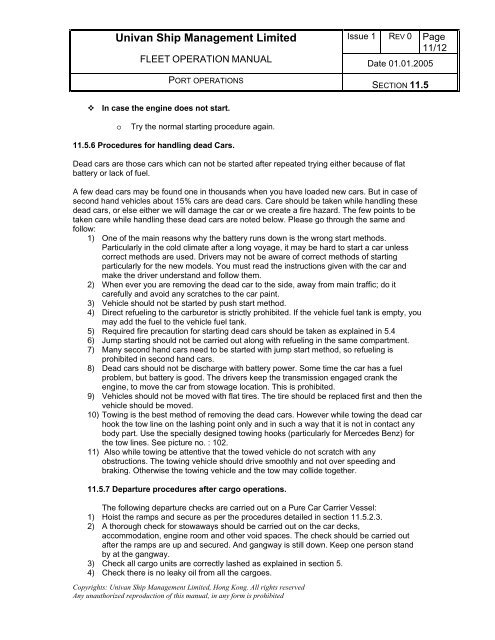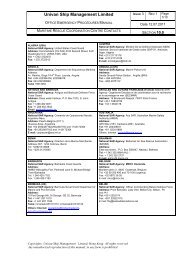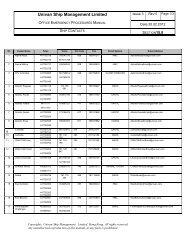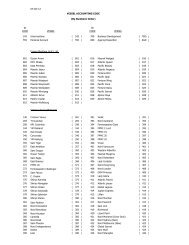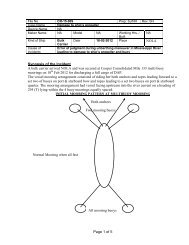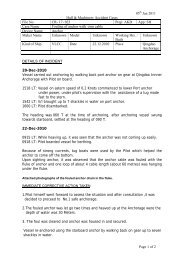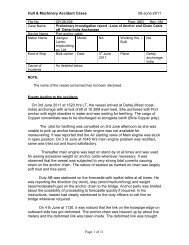Section: 11 CARGO OPERATIONS - Univan
Section: 11 CARGO OPERATIONS - Univan
Section: 11 CARGO OPERATIONS - Univan
You also want an ePaper? Increase the reach of your titles
YUMPU automatically turns print PDFs into web optimized ePapers that Google loves.
<strong>Univan</strong> Ship Management Limited Issue 1 REV 0 Page<br />
<strong>11</strong>/12<br />
FLEET OPERATION MANUAL Date 01.01.2005<br />
PORT <strong>OPERATIONS</strong><br />
In case the engine does not start.<br />
o Try the normal starting procedure again.<br />
<strong>11</strong>.5.6 Procedures for handling dead Cars.<br />
Copyrights: <strong>Univan</strong> Ship Management Limited, Hong Kong. All rights reserved<br />
Any unauthorized reproduction of this manual, in any form is prohibited<br />
SECTION <strong>11</strong>.5<br />
Dead cars are those cars which can not be started after repeated trying either because of flat<br />
battery or lack of fuel.<br />
A few dead cars may be found one in thousands when you have loaded new cars. But in case of<br />
second hand vehicles about 15% cars are dead cars. Care should be taken while handling these<br />
dead cars, or else either we will damage the car or we create a fire hazard. The few points to be<br />
taken care while handling these dead cars are noted below. Please go through the same and<br />
follow:<br />
1) One of the main reasons why the battery runs down is the wrong start methods.<br />
Particularly in the cold climate after a long voyage, it may be hard to start a car unless<br />
correct methods are used. Drivers may not be aware of correct methods of starting<br />
particularly for the new models. You must read the instructions given with the car and<br />
make the driver understand and follow them.<br />
2) When ever you are removing the dead car to the side, away from main traffic; do it<br />
carefully and avoid any scratches to the car paint.<br />
3) Vehicle should not be started by push start method.<br />
4) Direct refueling to the carburetor is strictly prohibited. If the vehicle fuel tank is empty, you<br />
may add the fuel to the vehicle fuel tank.<br />
5) Required fire precaution for starting dead cars should be taken as explained in 5.4<br />
6) Jump starting should not be carried out along with refueling in the same compartment.<br />
7) Many second hand cars need to be started with jump start method, so refueling is<br />
prohibited in second hand cars.<br />
8) Dead cars should not be discharge with battery power. Some time the car has a fuel<br />
problem, but battery is good. The drivers keep the transmission engaged crank the<br />
engine, to move the car from stowage location. This is prohibited.<br />
9) Vehicles should not be moved with flat tires. The tire should be replaced first and then the<br />
vehicle should be moved.<br />
10) Towing is the best method of removing the dead cars. However while towing the dead car<br />
hook the tow line on the lashing point only and in such a way that it is not in contact any<br />
body part. Use the specially designed towing hooks (particularly for Mercedes Benz) for<br />
the tow lines. See picture no. : 102.<br />
<strong>11</strong>) Also while towing be attentive that the towed vehicle do not scratch with any<br />
obstructions. The towing vehicle should drive smoothly and not over speeding and<br />
braking. Otherwise the towing vehicle and the tow may collide together.<br />
<strong>11</strong>.5.7 Departure procedures after cargo operations.<br />
The following departure checks are carried out on a Pure Car Carrier Vessel:<br />
1) Hoist the ramps and secure as per the procedures detailed in section <strong>11</strong>.5.2.3.<br />
2) A thorough check for stowaways should be carried out on the car decks,<br />
accommodation, engine room and other void spaces. The check should be carried out<br />
after the ramps are up and secured. And gangway is still down. Keep one person stand<br />
by at the gangway.<br />
3) Check all cargo units are correctly lashed as explained in section 5.<br />
4) Check there is no leaky oil from all the cargoes.


